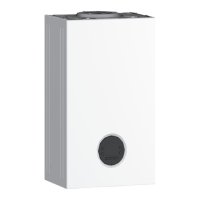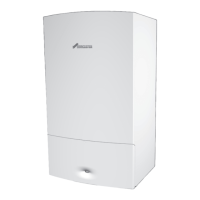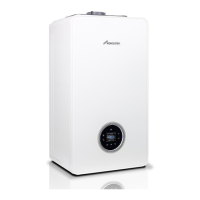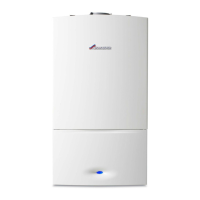Inspection and maintenance
57
Greenstar 4000 – 6 720 891 161 (2020/09)
7.3 Thermal disinfection
To prevent hot water from becoming contaminated by bacteria such as
legionella, we recommend thermal disinfection after long downtimes.
CAUTION
Risk of scalding:
During thermal disinfection, discharging unmixed hot water can cause
serious scalding.
▶ Run thermal disinfection at the factory default temperature of 70 °C
for a minimum of 3 minutes.
▶ Inform occupants of the premises of the risk of scalding.
▶ Perform thermal disinfection outside of the normal operating times.
▶ Do not discharge DHW unmixed.
To prevent the risk of scalding and to ensure mixed hot water, it is
advisable to fit a thermostatic mixing valve (TMV) at the point of use
(e.g. before the bath hot tap or shower).
Proper thermal disinfection involves the DHW system including the
draw-off points.
▶ Set the thermal disinfection in the service menu or hot water program
of the heating controller ( heating controller operating
instructions).
▶ Close DHW draw-off points.
▶ Set any DHW circulation pump to continuous operation.
▶ Wait until the maximum temperature is reached.
▶ Open all DHW draw-off points, from the nearest to the one furthest
away, and draw off hot water until hot water at a minimum of 70 °C
has flown from all draw-off points for at least 3 minutes.
▶ Restore the original settings.
8 Inspection and maintenance
DANGER
Risk of electric shock!
▶ Isolate electrical components from the power supply (230 V AC)
(fuse, circuit breaker) and secure against unintentional re-
connection before carrying out any work.
Information on safe isolation can be found in the Health and Safety
Executive guidance HSG85.
▶ Check for zero potential before proceeding with work, using test
equipment approved to GS38 to confirm that the electricity supply is
disconnected.
CAUTION
Mains supplies:
▶ Safely isolate both the gas and electrical supply before starting any
work on the appliance and observe all relevant safety precautions.
NOTICE
Personnel and equipment
▶ Any service work must carried out by competent registered
engineers.
▶ Service work must not be attempted if a calibrated CO/CO
2
analyser
and manometer are not available.
WARNING
Hot surfaces!
If the appliance has been operating components may be hot.
▶ Ensure precautions are taken when working on the appliance.
CAUTION
Annual maintenance checks:
Annual maintenance checks have to be conducted to ensure the
continued safe and reliable operation of the boiler.
▶ During each maintenance check, the gas valve, all gas joints and test
points should be checked for leakage using an analyser/sniffer.
▶ If a leak is found on the gas valve then it needs replacing as a gas valve
is a non-repairable component.
CAUTION
Component replacement:
▶ After replacement of a gas related component, where a gasket or seal
has been disturbed or replaced, check for gas tightness using a gas
sniffer/analyser.
▶ Also after re-assembly, carry out the following checks:
Fan pressure.
Flue gas analysis.
8.1 Inspection and maintenance considerations
• To ensure continued efficient operation the appliance must be
checked at regular intervals.
• The frequency of servicing will depend upon the particular
installation conditions and usage, however, at least an annual service
is recommended.
• The extent of the service work required on the appliance is
determined by the operating condition of the appliance when tested
by qualified engineers.
• After each service, the service interval record sheet at the rear of this
manual, must be completed.
See the following instructions for detail of some of the service
requirements:
▶ Check all joints and connections in the system and remake any that
show signs of leakage. Refill and re-pressurise if applicable as
described in the commissioning section.
▶ When it is frequently necessary to add water to maintain pressure in
the installation, even though no leaks have been discovered, perform
an expansion vessel check.
▶ Check that the condensate system is not obstructed, clean and refill
the condensate siphon.
▶ If the appliance is in a compartment or cupboard check that the
specified clearances around the appliance is clear.
▶ Check that the flue system is unobstructed and undamaged, clean/
replace as necessary.
– If fitted ensure the flue terminal guard is also unobstructed and
undamaged.
▶ Operate the appliance and take note of any irregularities.
– Refer to the fault finding pages for rectification procedure.

